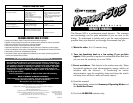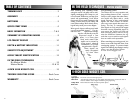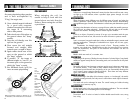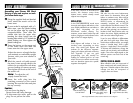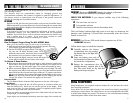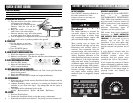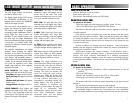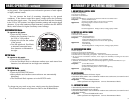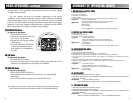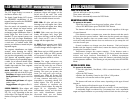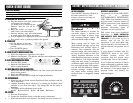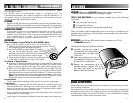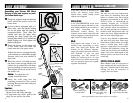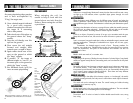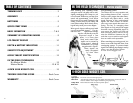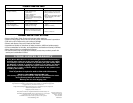
TERMINOLOGY
ELIMINATION
Reference to a metal being "eliminated" means that the detector will not emit a tone,
nor light up an LCD indicator, when a specified object passes through the coil’s
detection field.
DISCRIMINATION
When the detector emits different tones for different types of metals, and when the
detector "eliminates" certain metals, we refer to this as the detector "discriminating"
among different types of metals. Discrimination is a fixed-start-point elimination system.
NOTCH
Notching is the elimination of an item, or range of items, within the metallic spectrum.
We "notch-out" an object selectively. Objects to the left and right on the metallic
spectrum are retained. Notching creates a variable rejection window.
RELIC
A relic is an object of interest by reason of its age or its association with the past.
Many relics are made of iron, but can also be made of bronze or precious metals.
IRON
Iron is a common, low-grade metal that is often an undesirable target in certain metal
detecting applications. Examples of undesirable iron objects are old cans, pipes,
bolts, and nails.
Sometimes, the desired target is made of iron. Property markers, for
instance, can contain iron. Valuable relics can also be composed of iron; cannon
balls, old armaments, and parts of old structures and vehicles can also be
composed of iron.
FERROUS
Metals which are made of, or contain, iron.
PINPOINTING
Pinpointing is the process of finding the exact location of a buried object. Long-buried
metals can appear exactly like the surrounding earth, and can therefore be very hard
to isolate.
PULL-TABS
Discarded pull-tabs from beverage containers are the most bothersome trash items
for treasure hunters. They come in many different shapes and sizes. We have
incorporated special features into the detector to let you automatically eliminate the
most common types, using the AutoNotch Mode. Since there are many different
types, some must be "Notched-Out" manually.
GROUND BALANCE
Ground Balancing is the ability of the detector to ignore, or "see through," the earth’s
naturally occurring minerals, and only sound a tone when a metal object is detected.
WATERPROOF
The search coil can be submerged in water. The control housing and cable-to-housing
connection must, however, stay dry.
COINSHOOTING
Finding buried coins is the most popular metal detecting application. The most valuable
are very old; take care in unearthing them to avoid damage.
CACHE HUNTING
Pronounced “cash”. A cache is a buried or hidden valuable stored inside a case, strong
box, or bag.
314
IN THE FIELD TECHNIQUES
- Motion modes
When pinpointing a target, try drawing an “X”,
as illustrated, over where the tone is induced.
PINPOINTING
Accurate pinpointing takes practice
and is best accomplished by
“X-ing” the target area.
1. Once a buried target is indicated
by a good tone response,
continue sweeping the coil over
the target in a narrowing
side-to-side pattern.
2. Take visual note of the place on
the ground where the “beep”
sounds.
3. Stop the coil directly over this
spot on the ground.
4. Now move the coil straight
forward and straight back
towards you a couple of times.
5. Again make visual note of the
spot on the ground at which
the “beep” sounds.
6. If needed, “X” the target at
different angles to “zero in” on
the exact spot on the ground at
which the “beep” sounds.
7. Use All-Metal mode (p15) for
more accurate pinpointing.
COIL MOVEMENT
When swinging the coil, be
careful to keep it level with the
ground about one inch from the
surface. Never swing the coil like
a pendulum.
CORRECT
WRONG
The
coil
should
be swung
in a
half-
circle
movement
as
illustrated
here.
Repeat this
motion
every step
you take to
guarantee that
the area is being
covered thoroughly.



